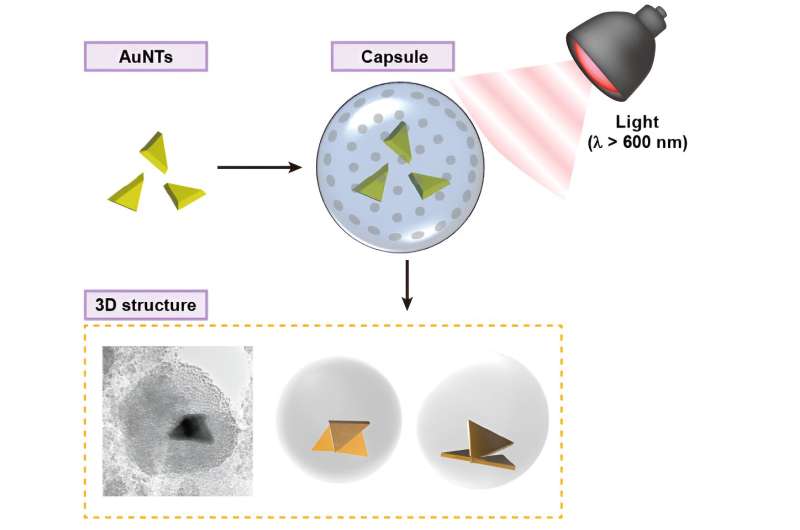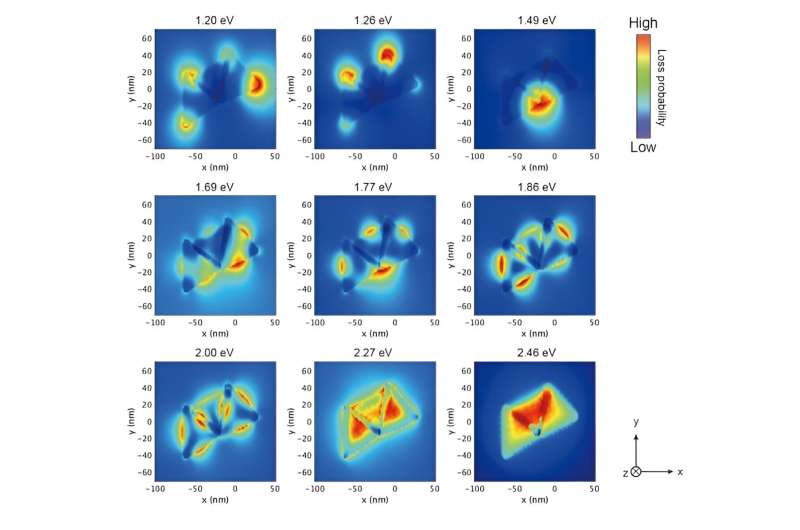

| Date | 12th, Dec 2023 |
|---|
 Schematic image of three-dimensional building of anisotropic gold nanoparticles under confinement in submicron capsules. Credit: Dr. Shota Kuwahara
Schematic image of three-dimensional building of anisotropic gold nanoparticles under confinement in submicron capsules. Credit: Dr. Shota Kuwahara
A research group led by Assoc. Prof. Shota Kuwahara of Toho University and Assoc. Prof. Masato Kuwahara of Nagoya University has developed a new technology that enables the creation of three-dimensional structures of gold nanoparticles confined within silica nanocapsules.
The assembled three-dimensional nanostructures are expected to exhibit new physical properties, and their unique optical properties can lead to the development of technologies such as high-sensitivity multi-color sensors. The results from this research were published in Nanoscale Advances.
When irradiated with light corresponding to localized surface plasmon resonance, which is dependent on the shape of the metallic nanoparticles, the nanoparticles can be fused by a strong electric field generated in a position-specific manner. In this study, the researchers utilized this technique to construct higher-order structures by linking gold nanoparticles together, aiming to extend their unique optical properties.
 The welding two AuNTs was placed on the xy plane, and observed from z-axis. Credit: Dr. Shota Kuwahara
The welding two AuNTs was placed on the xy plane, and observed from z-axis. Credit: Dr. Shota Kuwahara
Until now, it has been difficult to construct higher-order structures composed of gold nanoparticles due to the low contact probability between gold nanoparticles and the limited contact direction.
In this research, by confining multiple gold nanoparticles in a submicron-sized silica capsule with a mesoporous silica shell, the researchers increased the contact probability between the nanoparticles and created a space where gold nanoparticles could contact each other from every direction. This is the first-ever report of the successful fabrication of a three-dimensional gold nanostructure.
Electron energy loss spectroscopy (EELS) mapping calculations were performed based on scanning transmission electron microscope (STEM) images of the three-dimensional gold nanostructures obtained by this method. The results revealed that different plasmon modes are generated depending on the energy of the incident electromagnetic field and that the position of hot spots varies depending on the plasmon mode of the three-dimensional structure.
More information: Ryuichi Yamada et al, Three-dimensional building of anisotropic gold nanoparticles under confinement in submicron capsules, Nanoscale Advances (2023). DOI: 10.1039/D3NA00683B
Provided by Toho University
Citation: New technology to assemble three-dimensional structures using gold nanoparticles confined in nanocapsules (2023, December 12) retrieved 24 December 2023 from https://phys.org/news/2023-12-technology-three-dimensional-gold-nanoparticles-confined.html
This document is subject to copyright. Apart from any fair dealing for the purpose of private study or research, no part may be reproduced without the written permission. The content is provided for information purposes only.
